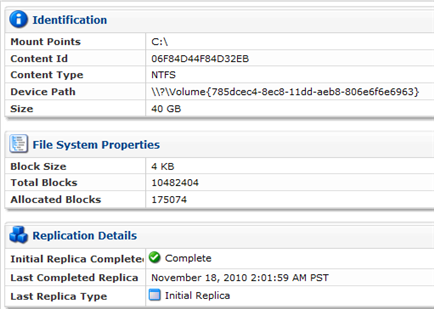Follow the instructions below to access the Devices assigned to a Disk Safe in your CDP Server.
1. Click on "Disk Safes" in the Main Menu to access the "Disk Safes" page.
| Standard Edition | Enterprise Edition | Advanced Edition |
|---|---|---|
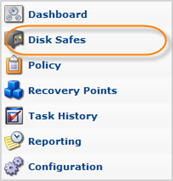 |
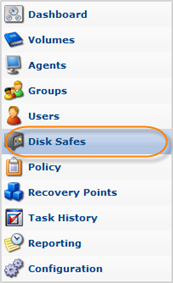 |
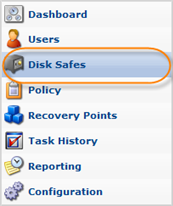 |
2. In the "Disk Safes" list, find a Disk Safe and click on the "Manage Devices" icon in the "Actions" column for this Disk Safe. 
| Tip To find a Disk Safe, you can use the Basic and Advanced List Filters. See Customizing the Disk Safes List. |
3. The "Devices" window opens. On the right, the Devices already assigned to the Disk Safe are shown. On the left, you can view the list of all Devices that exist on the Host.
| Tip If you need to exclude folders/files located on a Device, you can do it while defining the Policy's properties. See Excluding Files and Folders. |
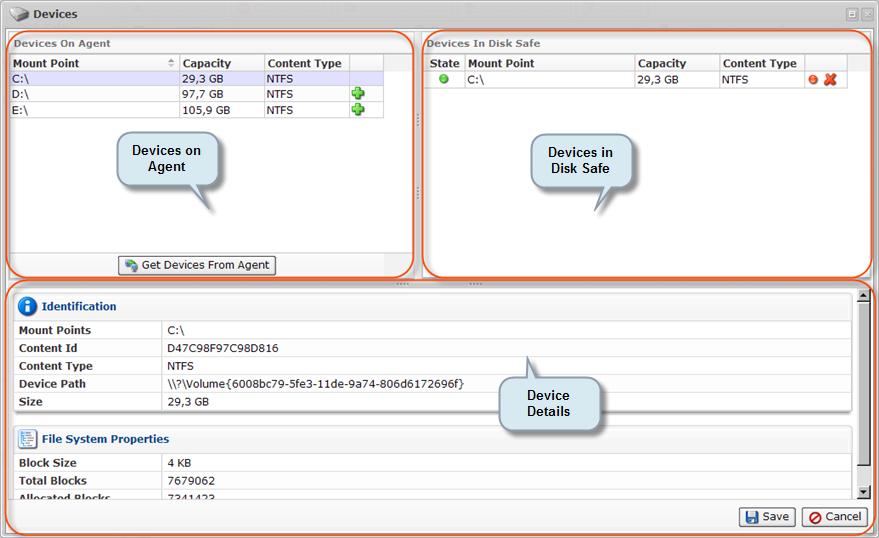
In the "Devices" window, there are the following main areas:
- Devices on Agent
- Devices in Disk Safe
- Device Details
Devices on Agent
This pane provides you with information about Devices that currently exist on the Host. To view the list of Devices, click the "Get Devices from Agent" button.
Columns:
- Mount Point - In Unix-like systems, a mount point is the location in the operating system's directory structure where a mounted file system appears. For example, many modern Linux distributions automatically mount the CD drive as /media/cdrom, so the contents of the CD drive will appear in the /media/cdrom directory. The equivalent to mounting in Microsoft Windows is known as mapping a drive. Since Windows 2000, NTFS devices can also be mounted to empty NTFS folders.
- Capacity - How many resources are available on the Device (gigabytes, megabytes, or kilobytes; blocks).
- Content Type - The file system created on the Device. Example: NTFS.
- Actions - Provides access to actions available for the selected Device:
- Add - See Adding Devices.

Devices In Disk Safe
This pane provides you with information about Devices that are currently assigned to the Disk Safe.
- State - Graphically indicates the Device status. If the Device is enabled (green icon), then it is available for replication. If the assigned Device is disabled (red icon), then it will not be backed up (replicated.) See Disabling Devices.
- Mount Point - In Unix-like systems, a mount point is the location in the operating system's directory structure where a mounted file system appears. For example, many modern Linux distributions automatically mount the CD drive as /media/cdrom, so the contents of the CD drive will appear in the /media/cdrom directory. The equivalent to mounting in Microsoft Windows is known as mapping a drive. Since Windows 2000, NTFS devices can also be mounted to empty NTFS folder.
- Capacity - How many resources are available on the Device (gigabytes, megabytes, or kilobytes; blocks).
- Content Type - The file system created on the Device. Example: NTFS.
- Actions - Provides access to actions available for the selected Device:
- Disable/Enable - See Disabling Devices.
- Remove - See Removing Devices.

Device Details
The "Details" pane provides the following information about the selected Device:
- Identification
- File System Properties
- Replication Details
Identification
- Mount Points - In Unix-like systems, a mount point is the location in the operating system's directory structure where a mounted file system appears. For example, many modern Linux distributions automatically mount the CD drive as /media/cdrom, so the contents of the CD drive will appear in the /media/cdrom directory. The equivalent to mounting in Microsoft Windows is known as mapping a drive. Since Windows 2000, NTFS devices can also be mounted to empty NTFS folders.
- Content Id - Example: 0389746389719DC.
- Content Type - The file system created on the Device. Example: NTFS.
- Device Path - Hardware address of the Device. Example:

- Size - The measuring characteristic of Device to show how large it is, in other words, what volume is available on the Device. Example: 8.0 GB.
File System Properties
- Block Size - A file system property which indicates a nominal length of a block in the Device. Example: 4.0 KB.
- Total Blocks - A file system property which indicates the total number of blocks on the Device. Example: 10484412.
- Allocated Blocks - A file system property which indicates the number of blocks with data. They belong to block allocation map used for rapid file access. Example: 5374676.
Replication Details
- Initial Replica Completed - Indicates whether Initial Replica is completed or not.
- Last Completed Replica - Shows the date and time of the last completed replica.
- Last Replica Type - Shows the type of last completed replica.
